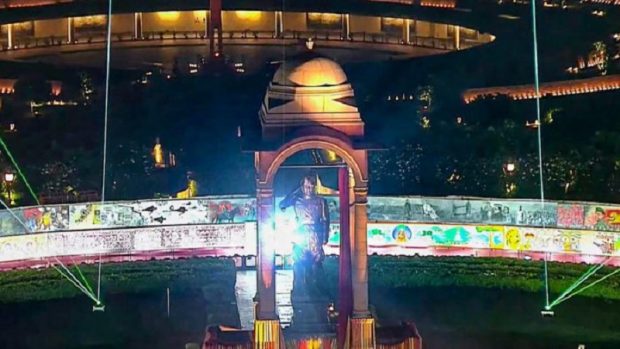
‘Netaji’ sits in India Gate canopy vacated by King George V in 1968
PTI, Sep 9, 2022, 8:57 AM IST

Image credit: PTI
New Delhi: The famed canopy of India Gate where a grand statue of freedom fighter Subhas Chandra Bose was on Thursday unveiled marked a milestone transition in the history of India, as ‘Netaji’ was accorded a place that was once occupied by an imposing marble statue of British monarch King George V.
The canopy, standing on four columns of the Delhi Order devised by Sir Edwin Lutyens, had been lying empty since the statue of the king was removed in 1968.
Prime Minister Narendra Modi on Thursday unveiled the 28-ft-tall statue of Bose, and also inaugurated the newly-christened ‘Kartavya Path’, the stretch of road from Rashtrapati Bhavan to India Gate, earlier known as Rajpath.
Kingsway or Rajpath, was a “symbol of slavery”, and it has now been consigned to history, Modi said after inaugurating the Kartavya Path, and also mentioned the king’s statue that had occupied the canopy.
Official sources had earlier said that the installation of the statue would be a case of India “reclaiming” its history and shedding a part of its colonial past.
Before the ‘monarch’ was relegated to the grounds of the Coronation Park in northwest Delhi — the site of the 1911 coronation durbar, till 1968, he stood under the canopy watching the India Gate, Kingsway — the ceremonial boulevard that ran up to the Raisina Hill on which the president’s house is built.
Soon after Independence, Kingsway was renamed Rajpath and Queensway running perpendicular to it was rechristened Janpath. Rajpath on Wednesday was officially renamed Kartavya Path.
The statue of George V was unveiled in 1939 by the then Viceroy Lord Linlithgow as a memorial to the British monarch under whose reign ‘New Delhi’ was built as the British Raj’s capital, according to archival records.
Born in 1865 in London, George V was crowned king in 1910, and the next year, he travelled along with his consort Queen Mary to India to attend the famous 1911 Delhi Durbar, where he had also announced the shifting of the capital to Delhi from Calcutta.
King George ruled until his death in January 1936, after which memorials were built and statues erected in various cities under the British Empire, the most notable among them being New Delhi — the administrative seat of a country, which was held as the ‘Jewel in the Crown’.
The statue, crafted out of white marble, was designed by famous British sculptor Charles Sargeant Jagger, and its models were exhibited in 1933 and 1935 at the Royal Academy, according to victorianweb.org, a scholarly resource.
Jagger died in 1934 before he could complete his work, which was then completed by other artists, it says.
According to the archives, the statue of George V beneath the canopy, endowed with royal motifs and surrounded by a pool of water, was unveiled by the then viceroy on November 14, 1939.
“The King was everybody’s King. More particularly can we who are gathered here be sensible of this personal relationship with the Sovereign, who 28 years ago announced his decision to restore Delhi to its ancient birthright and who laid the first stones of his Imperial Capital,” Viceroy had said in his speech, according to the Indian Information published in 1939.
According to archival records and old books, the ‘George V Memorial’ was originally planned to be erected next to the All-India War Memorial Arch (now called India Gate).
Lutyens, the chief architect of New Delhi, designed the canopy and the layout of the memorial.
Bose’s statue is part of the Centre’s Rs 13,450-crore Central Vista project, which will have a new Parliament building, new office and residences for the prime minister and vice-president, and new ministry buildings.
The North and South Blocks, the secretariat buildings flanking Rashtrapati Bhavan, will be converted into museums.
A team of sculptors spent 26,000 man-hours of “intense artistic endeavour” to carve a grand statue of Bose weighing 65 metric ton from a monolithic block of granite, weighing 280 metric ton, the Culture Ministry said on Wednesday.
A 100-ft-long truck with 140 wheels was specially designed to bring the giant granite statue to New Delhi from from Khammam in Telangana, travelling 1,665 km, it said.
The statue is completely “hand sculpted using traditional techniques and modern tools”. The team of sculptors was led by Arun Yogiraj.
It has been installed at the same place where a ‘hologram statue’ of Netaji was unveiled earlier this year on Parakram Diwas (January 23) by the prime minister to mark the 125th birth anniversary of Bose.
Udayavani is now on Telegram. Click here to join our channel and stay updated with the latest news.
Top News

Related Articles More

Air pollution: SC flags Delhi govt’s failure to implement GRAP-4 curbs on entry of trucks

Baba Siddique murder: Man held from Akola, 26th arrest in case

SC notice to Gyanvapi mosque committee on plea for ASI survey of ‘shivling’ area

Delhi court stays defamation case against CM Atishi

Sambhal Jama Masjid row: Friday prayers held peacefully amid tight security
MUST WATCH
Latest Additions

Air pollution: SC flags Delhi govt’s failure to implement GRAP-4 curbs on entry of trucks

Drugs worth Rs 6 crore seized in Bengaluru, five arrested

Siddaramaiah urges Nirmala Sitharaman to address NABARD’s loan cuts to farmers

Satwik-Chirag enter semifinals, Lakshya loses to Antonsen in China Masters

BJP stages protest against Congress govt in Karnataka over Waqf properties row
Thanks for visiting Udayavani
You seem to have an Ad Blocker on.
To continue reading, please turn it off or whitelist Udayavani.




















